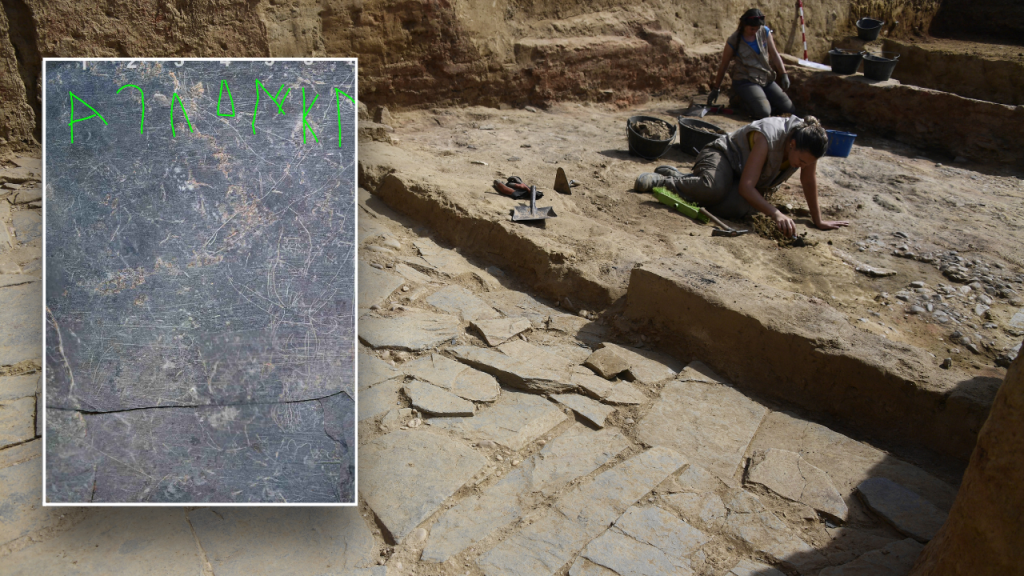Spanish archaeologists recently announced the discovery of an ancient stone with perplexing symbols carved onto it. The symbols are believed to be an ancient alphabet, making the slab the third-ever “southern Paleo-Hispanic alphabet of which there is evidence,” according to the Spanish National Research Council (CSIC). The stone was found at the Casas del Turuñuelo, Tartessian ruins in Badajoz, Spain, and dates back to around 600 B.C. Tartessos was an ancient civilization that occupied the southern Iberian Peninsula over 3,000 years ago and is considered “lost” due to the scarcity of surviving remnants. The discovery of the slate is part of the “Building Tartessus” project, which aims to characterize Tartessian material culture through architectural analysis.
The stone tablet features a sequence of 21 signs within its framework, alongside figures of warriors. Joan Ferrer i Jané, a researcher from the University of Barcelona, identified the artifact as Tartessian and recognized a Paleo-Hispanic sign that cannot be confused with any other. This alphabet, with 27 signs, is the only complete one known to date, with another fragmented version found in an excavation in Villasviejas del Tamuja. The tablet is considered incomplete, with experts believing it once held up to 32 symbols, with at least six lost in the split area of the piece. If completely symmetrical and occupying three of the four sides of the plate, it could have held 32 signs. Ferrer suggests the alphabet has an initial sequence of ABeKaTuIKeLBaNS?ŚTaUE.
The main objective of the “Building Tartessus” project is to characterize Tartessian material culture through analyzing adobe buildings and introducing architecture as an integrated element in the territory. The discovery of the stone tablet at the Casas del Turuñuelo site was a complete surprise for experts and adds valuable information to the understanding of Tartessian culture. The findings from the tablet, with its unique alphabet, are significant in shedding light on the language and communication methods of this ancient civilization. The Tartessians were an enigmatic society, and the discovery of this stone further deepens our knowledge of their history and written communication.
The stone tablet’s discovery provides insight into the language and written communication of the ancient Tartessian civilization. The unique alphabet found on the tablet, believed to be the third-ever “southern Paleo-Hispanic alphabet,” offers a rare glimpse into the linguistic practices of this lost civilization. Experts have identified 21 signs on the tablet, with the potential for it to have originally contained 32 symbols if completely symmetrical. Joan Ferrer i Jané’s research into the alphabet’s sequence and structure provides crucial information in deciphering the meaning behind the symbols and further understanding Tartessian writing.
The discovery of the stone tablet at the Casas del Turuñuelo site in Spain unveils a valuable piece of Tartessian history. The enigmatic civilization, considered “lost” due to the paucity of remaining artifacts, is slowly being pieced together through archaeological findings like this stone. The “Building Tartessus” project aims to shed light on Tartessian material culture and architecture, with the tablet’s unique alphabet adding an additional layer of understanding to their society. The experts’ analysis of the symbols and signs on the stone offers a glimpse into the communication methods of the Tartessians and provides important insights into their language and written records.
The significance of the stone tablet’s discovery lies in its contribution to unraveling the mysteries of the ancient Tartessian civilization. The unique alphabet found on the tablet, identified as the third southern Paleo-Hispanic alphabet known, offers a rare glimpse into the linguistic practices of this lost society. The stone’s symbols provide valuable clues to understanding Tartessian language and communication methods, adding depth to our knowledge of this enigmatic civilization. Through ongoing research and analysis, archaeologists and experts hope to continue deciphering the meanings behind the symbols on the tablet, further illuminating the history and culture of the Tartessians.


